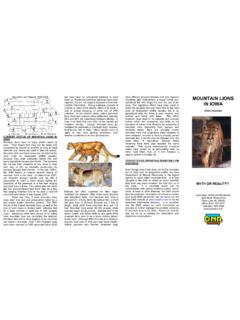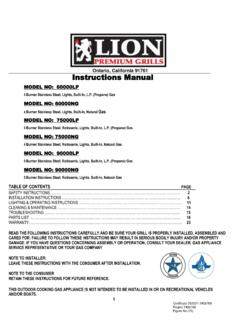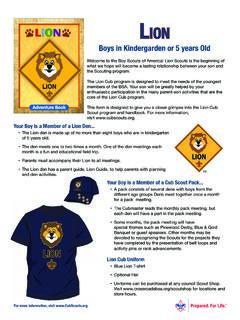Transcription of MOUNTAIN LIONS, DEER AND PREDATOR CONTROL
1 70 MOUNTAIN LIONS, deer AND PREDATOR CONTROL BILLY PAT McKINNEY, Texas Parks and Wildlife, Box 354, Marathon, Texas79842. PREDATOR -prey relationships are complex, and not all parameters are wellunderstood. The MOUNTAIN lion (Felis concolor) is a high-class PREDATOR , and a controversialspecies. MOUNTAIN lions prey on all age classes of mule deer (Odocoileus hemionus) andwhite-tailed deer (O. virginianus). Combinations of factors influence the number of deerkilled by MOUNTAIN lions in a given area over a period of time. Climatic conditions, deerdensity, cover, the abundance and diversity of prey species and MOUNTAIN lion density are allfactors. To understand the effects of MOUNTAIN lion predation on deer populations wildlifemanagers need to have a working knowledge on the ecology of both species beforemanagement decisions are implemented.
2 In certain cases PREDATOR CONTROL is an effectivewildlife management tool when benefits will be derived by CONTROL measures. INTRODUCTIONThe MOUNTAIN lion also known ascougar, puma and panther, has been anintegral part of the Texas fauna forthousands of years as evidenced by thepaintings and pictographs of NativeAmericans. Lions were one commonthroughout the state of Texas, but sinceAnglo settlement, they have been mostlyconfined to the isolated and rugged areas ofthe state. Lions now appear to be movingback into historic ranges in other areas ofthe state. MOUNTAIN lions are controversialanimals that often evoke love-hate feelingson the part of humans. Whatever one'sperspective, MOUNTAIN lions are fascinatingand little understood predators that play animportant role in ecosystems.
3 BIOLOGYM ountain lions are high-classpredators, and a basic knowledge of theirbiology is important in understanding therole of the MOUNTAIN lion as PREDATOR anddeer as prey. MOUNTAIN lions are reddish brown to tawnyin color, this coloration aids incamouflaging them as they stalk their lions are solitary animals. Theyare active in the early morning and at dusk(crepuscular) and at night (nocturnal).Normal weights on adult males in westernTexas average 100-150 pounds, and 55-90pounds for adult females (McKinney 1996). Adult males and females are onlytogether for a 3 to 5 day period duringbreeding season. Lions may breed at anytime during the year, but most litters areborn in the summer and fall. Females firstbreed when they are around 2 years of between litters average from 18months to 2 years.
4 Average litter size isnormally 2 to 3 young. The gestation periodis about 90 days. Female lions picklocations within their home range that offerscover and security for their young. Kittensmay be left unattended for hours while themother hunts. Females may leave their71kittens in heavy brush, rockslides, caves oroverhangs. The growing cubs stay with thefemale until they are 12 to 24 months old, atwhich time they disperse and began thesearch for their home range. Dispersal ofyoung lions depends on the distance tounoccupied habitat. Generally, sub-adultmales disperse further than females. The size of a lion's home range isdetermined by a variety of factors: preydiversity and abundance, topography, andmountain lion density. Male home rangesaverage roughly times larger than thoseof females.
5 The male's range usuallyencompasses the range of several research in western Texas hasindicated a degree of overlap in homeranges of adult males, however malesliterally do not share home ranges (Pittmanet al 2000). The home range of an adultmale may vary from 80 square miles (207km2) to over 200 square miles (518 km2),while females ranges normally average 20square miles (51 km2) to as much as 100square miles (259 km2). Female ranges tendto have some degree of overlap with thoseof other females, yet they remain solitary. HOW MOUNTAIN LIONS KILLL ions are opportunistic, preying ona wide range of animals. As with anycarnivore, it is impossible to predict what alion will prey upon at a given time. Lionsstalk they prey and kill by crushing theirvictim's esophagus, resulting in killing technique is biting the neck,thus separating the vertebrae.
6 In some case,lions will bite through the skull. Lions are meticulous about theirkills compared to other carnivores. Once thekill is made the lion will drag the prey to acache area. Lions cache their kills in areasof heavy cover. They often cover the killwith grass, leaves, dirt or other debris, butthey do not bury their kill. They oftenremove the internal organs and cover themup close to the kill site. Lions will uncovertheir kill and feed, then drag the carcass toanother area and cover it again The carcassnormally remains intact as the lion begins tofeed at the shoulders and ribs, eventuallymoving to the hindquarters and loin onsubsequent ON deer NUMBERSL ions will predate on all age classesof deer . Newborn fawns and large bucks areparticularly more susceptible to lionpredation after the rut when they seeksolitude to recuperate from breeding of deer present more eyes and earsto alert them to danger than a an area where small mammals areabundant lions will have less impact on deernumbers.
7 Smaller mammals act as bufferspecies thus reducing predation on managers should not over-harvestsmall game and nongame species that act asbuffers. For example, MOUNTAIN lions willprey on javelina (Tayassu tajacu), nine-banded armadillo (Dasypus novemcinctus),black-tailed jackrabbit (Lepus californicus),porcupine (Erethizon dorsatum), skunks(Mephitis spp.) and wild turkey (Meleagrisgallopavo). In areas where deer are theprimary prey species, and small mammalsare not common lions will prey on deermore the yearly cycle there are "X"number of days the lion will hunt, and whenthe lion has made an adequate kill he willnot hunt. An example of this is when a lion72kills a javelina it may take him out of thekilling cycle for up to two days. A common myth relates thatmountain lions will completely kill out adeer population.
8 In all probability, the deerand the lion evolved together and if theabove statement were true lions would haveextirpated deer many years ago. A look atour national parks where all species are leftto their own means to survive is a goodexample of why this does not occur. Deerand MOUNTAIN lions coexist in the parkswithout manipulation by man, and deerpopulations tend to remain stable. Whatwildlife managers must recognize is thecombination of lion predation and hunterharvest creates the situation where deer areunable withstand natural predation andharvest combined. The result can be asignificant decline in deer numbers. In an area of low deer densitymountain lions can suppress populationincrease. Resident lions have a higherimpact on deer numbers than a transientlion.
9 Transient and resident male lionsutilize larger areas and deer kills will not beconcentrated in one area. In retrospect, aresident female with a much smaller homerange will make more kills in one area,particularly when she has kittens to feed. Another factor that contributes to therate at which a lion will make a kill is theweather. Lions prefer fresh meat, at timesthey will scavenge. In cooler weather themeat doesn't spoil and this allows the lion tostay with the kill until he consumes it,which in turn will lessen the number of deerkilled. On the other hand, in hot weather adeer kill will spoil quickly. This necessitatesthe need for the lion to make another essence, there are a number of factorsthat contribute to MOUNTAIN lion predationon deer herds. PREDATOR CONTROLWhen deemed necessary, predatorcontrol can help a dwindling deerpopulation recover.
10 One must understandthat it requires a long-term commitment,both in man- power and money to obtainresults. The integrity of the MOUNTAIN lionpopulation when fractured by removal oflions will for a short period of time may sound contradictory since you areremoving lions, but in reality you arecreating a vacuum effect. When you removeresident lions that have established homeranges you create a void, other resident lionsthat have home ranges that may overlap theindividual you removed now find thatterritory empty. This allows them to expandtheir range, as well as create openings fortransient lions to establish a new homerange. Short- term PREDATOR controlprograms do little but aggravate thesituation. Long-term PREDATOR CONTROL willshow results. Professionals that have theknowledge and experience to effectivelytarget the particular species that is creatingthe problem should handle PREDATOR CONTROL ;non-target animals should not be affected inpredator CONTROL efforts.










